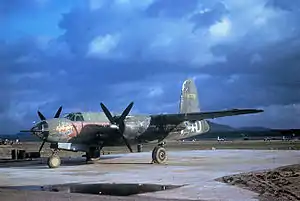Flak-Bait
Flak-Bait is a Martin B-26 Marauder aircraft that holds the record within the United States Army Air Forces for the number of bombing missions survived during World War II. Manufactured in Baltimore, Maryland as a B-26B-25-MA, by Martin, it was completed in April 1943 and christened Flak-Bait by its first assigned pilot, James J. Farrell, who adapted the nickname of a family dog, "Flea Bait". Flak-Bait was assigned to the 449th Bombardment Squadron, 322d Bombardment Group stationed in eastern England.[1][2]
| Flak-Bait | |
|---|---|
 | |
| Flak-Bait at Andrews Field, England, 1944 | |
| Type | Martin B-26 Marauder |
| Manufacturer | Glenn L. Martin Company |
| Serial | 41-31773 |
| First flight | April, 1943 |
| Owners and operators | United States Army Air Force (USAAF) |
| In service | April, 1943 to December 1946 |
| Fate | Museum display |
| Preserved at | Under preservation at Smithsonian Institution's Steven F. Udvar-Hazy Center. |
During the course of its 202 (207 including its five decoy missions[2]) bombing missions over Germany as well as the Netherlands, Belgium, and France, Flak-Bait lived up to its name by being shot with over 1,000 holes, returned twice on one engine (once with the disabled engine on fire), lost its electrical system once and its hydraulic system twice. Despite the level of damage it received, none of Flak-Bait's crew were killed during the war and only one was injured. Over two years of operations Flak Bait accumulated 725 hours of combat time and participating in bombing missions in support of the Normandy Landings, the Battle of the Bulge, and Operation Crossbow against V-1 flying bomb sites.[1][2][3]
On March 18, 1946, Major John Egan and Captain Norman Schloesser flew Flak-Bait for the last time, to an air depot at Oberpfaffenhofen in Bavaria. There the famed bomber was disassembled, crated, and shipped, in December 1946, to a Douglas factory in Park Ridge, Illinois.[4]
.jpg.webp)
The aircraft is currently on display in the Mary Baker Engen Restoration Hangar at the Steven F. Udvar-Hazy Center in Chantilly, Virginia.
A series of red-colored bombs are painted on the side of the aircraft, each representing an individual mission (202 bombs in total). White tails painted on the bombs represented every fifth mission. There is one black-colored bomb which represents a night mission. In addition to the bombs, there are also six red ducks painted on the aircraft representing decoy missions. There is also a detailed Nazi Swastika painted above a bomb to represent Flak-Bait's only confirmed kill against a German aircraft.[5]

References
- Spenser, Jay P., "Flak Bait: Biography of an Intrepid Marauder," Airpower (vol. 8, no. 5, Sept. 1978), pp. 36–57.
- Crosby, David (June 12, 2006). "B-26B Marauder: American Bomber in World War II". Historynet. Retrieved 28 April 2015.
- "Martin B-26B-25-MA Marauder "Flak-Bait"". Smithsonian National Air and Space Museum. Retrieved 28 April 2015.
- Jones, Tom (May 2015). "207 Flights, Hundreds of Holes". Smithsonian Magazine. Retrieved 21 December 2022.
- "A Brief History of "Flak-Bait"". Smithsonian National Air and Space Museum. Archived from the original on 2021-12-19. Retrieved 21 March 2018.